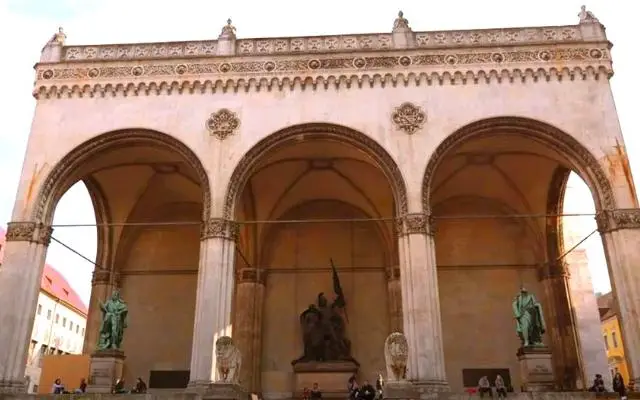This is the story of the incredibly imposing and (almost) architecturally plaigiarant Munich Feldherrnhalle (Field Marshals’ Hall) on Odeonsplatz.
Obviously historically important stories are behind any of the stunning architectural buildings that abound in Munich today, but the story of the Feldherrnhalle – whilst tainted by negative consequence – is one of the most fascinating.
In this article, we reveal All You Need To Know About the Feldherrnhalle so hopefully, you’ll be convinced to visit, and marvel at this public outdoor gallery yourself.
KEY TAKEAWAYS:
- Find out exactly What the Feldherrnhalle is, who built it and why, plus its connection to Italy.
- Discover what the Feldherrnhalle is used for today and what it means to the people of Munich.
- Gain visitor insights, get directions to the Feldherrnhalle, and more.
What is the Feldherrnhalle?
The Feldherrnhalle, or the Field Marshals’ Hall, is a colossal architectural Loggia-styled landmark from 19th century Germany located in central Munich on Odeonsplatz.
With magnificent archways measuring 20 meters each, it was originally constructed to be an identifying feature of Bavarian Military glory on Ludwigstrasse. In essence, the Feldherrnhalle is a war memorial, one of quite a few in Munich.
Featuring several sculptures, and showcasing an imposing staircase flanked by two sentinel lions, this is one of the most recognizable structures in the area and stands in the midst of many other Munich landmarks and attractions.
Inspiration For The Feldherrnhalle
Not many people know this, but the Feldherrnhalle was inspired by a very similar structure that can be found in Florence, Italy. This font of inspiration is the Loggia dei Lanzi, a gothic architectural masterpiece built during the Renaissance period.
If you’ve ever been to the Loggia dei Lanzi, you might be a little confused when viewing the Field Marshals Hall in Munich, as seriously, the two are literally identical with only the statues and the more impressive staircase being the only points of difference.
Who Built the Feldherrnhalle
Construction of the Feldherrnhalle was completed between 1841 & 1843. It was both built and born via the vision of designer Friedrich von Gärtner under instruction from King Ludwig I.
The planning and construction team of the king, along with his court architect Leo von Klenze, and of course von Gärtner himself, were certainly not above architecturally plagiarising, such was their ambition to realise the vision of Ludwig, and create an “Athens on the Isar”.
Funnily enough though, they copied many famous structures from throughout Europe to achieve this goal and not just Grecian-styled architecture – but that’s another story!
Obviously, the building’s main intent – at that time – was to honour and commemorate the Bavarian Army for its military victories in various battles over the years.
However, the reality is that Ludwig had huge plans for his beloved Munich, and this particular area of the city was earmarked to be a destination that would rival the wonderful Avenue des Champs-Élysées in Paris, and similarities to the Parisian counterpart are striking.

Statues of the Feldherrnhalle
The different statues and sculptures adorning the structure have their own story to tell.
The bronze statues pay tribute to two military leaders, Johann Tilly and Karl Philipp von Wrede, who each led different Bavarian battles to success.
Both of these historical figures seem an odd choice for commemoration, especially considering the main intent of the Felherrnhalle was to exalt the Bavarian Army and its conquests.
Wrede’s popularity was increased greatly after (supposedly but disputed by some historians) leading the Bavarian forces in opposing the Austrian invasions of 1805 but was known more for being allied with Napoleon, than for any sort of Bavarian expansion.
And Tilley, who interestingly wasn’t actually even Bavarian, played a crucial role with the Bavarian Army in the 30 years war of the 1600s but fought for the glory of the Catholic Church rather than for the glory of Bavaria.
There’ve been additions to the Feldherrnhalle over the years, including two lions sculptured from Lasa Marble that was added in 1905. These lions play a tribute to the Franco-German war of 1870-1871 and were the creation of sculptor Wilhelm von Rümann, a patron and artist from the Academy of Art in Munich.
Where is the Feldherrnhalle in Munich?
Located right on Odeonsplatz between the Munich districts of Altstadt-Lehel and Maxvorstadt the Feldherrnhall stands at the very south of Ludwigstraße (Munich’s Royal Boulevard) in central Munich.
Leading north, Ludwigstraße stretches to the Siegestor Munich where there stands a smaller version of the Arc de Triomphe, and in between stands some of the grandest architecture in Germany.
Directly adjacent to the Feldherrnhalle you’ll find the very yellow Theatinerkirche Church on one side, and on the other side, the Munich Residenz and Hofgarten Munich
This is one of the most visited public places in Munich and it’s likely that any visitor to the city will find themselves in the area – especially if they plan on spending a number of days in the Bavarian Capital.
The Dark Past of The Feldherrnhalle
The Feldherrnhalle didn’t actually attract much popularity or attention from the Munich public until the rule of Hitler when in 1923 he, he and his followers, staged a coup against the ruling government. This became known as the Beer Hall Putsch.
Hitler’s followers, defeated at this exact location, ensured the infamy of the Feldherrnhalle which thereafter became a popular hangout spot for the National Socialists.
Hitler himself was tried for treason after the failed coup and was imprisoned.
When Hitler finally gained rule, he installed a bronze tablet at the Feldherrnhalle in order to commemorate the (so-called) martyrs who lost their lives to the movement during the coup.
Under Hitler’s rule, it was previously illegal to enter the Feldherrnhalle without performing a Nazi salute but obviously, this rule has long since been eradicated.
The Feldherrnhalle, as one of Munich’s primary war memorials, also holds significance for the German involvement in both World Wars. However, after the desecrations perpetrated by the Nazi invasions in Europe, the Munich public now prefers to view the monument as a tribute to peace, rather than as a beacon of a tyrannical leader.
How to Get to the Feldherrnhalle
Easily found on foot or via public transport Odeonsplatz is readily accessible and just to the north of Munich Old Town
By Foot: Walk north from Marienplatz up Weinstraße then onto Theatinerstraße which leads directly to Odeonsplatz. This will be around an 8-minute walk.
By Train: The U-Bahn subway services U3, U4, U5, and U6 all stop at Odeonsplatz
By Bus: Buse numebers 100, 153, N40, N41 and N45 all have stops nearby.
For all the most up-to-date information on public transport please check out our article on Getting Around Munich. We’ve also a very helpful page detailing Maps of Munich that could assist you in finding your way about Munich easier.
Feldherrnhalle Location Map
Should YOU Visit the Feldherrnhalle Munich?
If you’re someone who has an interest in history, particularly military history, then you’ll very much enjoy a visit to the Feldherrnhalle.
For others, this might simply be a spot of interest that you might quickly move on from after perhaps capturing another Instagrammable shot of Munich.
The view down Ludwigstraße where the Siegestor stands in the center of your shot is amazing, and you can really get a scope of the area when viewed from between the lion statues at the top of the Feldherrnhalle stairs.
What’s great about the Feldherrnhalle and its location is that it is a bustling part of the city. So if you’re shopping nearby, you could have a quick pit spot at the Feldherrnhalle and see for yourself the history that was created at this famous location.
Many people utilise this very spot for people watching as the foot traffic here is very high and there is always something of interest going on at Odeonsplatz.
Feldherrnhalle | Our Verdict
The Feldherrnhalle is one of the many Munich public structures that stands open to visitors 24 hours a day, so you can visit here whenever you find the time.
And just as the Loggia dei Lanzi in Florence serves as a common area & popular spot to hang out for the people of Florence so to does the Feldherrnhalle adopt a similar function for Müncheners. From its construction and through its darker days, this structure has become a part of the Munich psyche.
The Feldherrnhalle today, however, is much less of a war memorial and much more of a positive public space regularly hosting street performers, markets, impromptu theater, and other artistic pursuits. Each July the area is even transformed to accommodate an orchestra who perform magical open-air recitals.
We think the Feldherrnhalle is well worth a visit, perhaps we’ll see you sitting on the steps there sometime!
CHEERS and thanks for reading!

